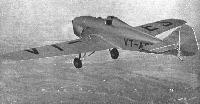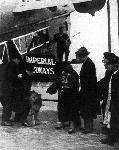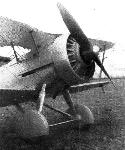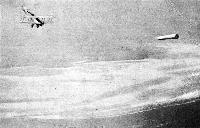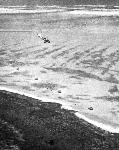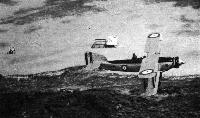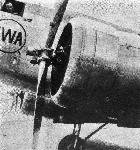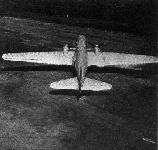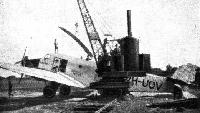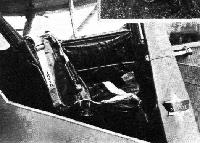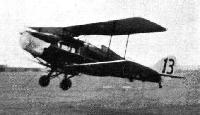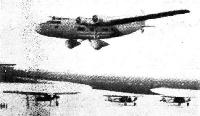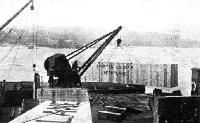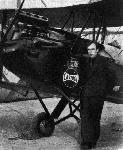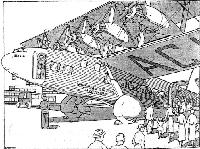Фотографии
-
Регистрационный номер: VT-AES AN INDIAN VENTURE: Mr. Man Mohan Singh, chief pilot to the Maharajah of Patiala, and who flew from England to India in 1930, is making a flight from England to Cape Town in the Miles "Hawk" ("Hermes IV") shown in the accompanying illustration. This machine has been fitted with large tanks giving a range of about 1,800 miles. Mr. Singh, who has been provided with a Shell Carnet to enable him to obtain Shell aviation products wherever he goes, will follow the normal route through Italy and along Imperial Airways' route. From the Cape he will return to India via Egypt.
Самолёты на фотографии: Miles Hawk / M.2 - Великобритания - 1932
-
Регистрационный номер: G-ACLI [2] THE "HAWK SPECIAL": This is the latest machine turned out for Phillips & Powis, Ltd., of Reading, by Mr. G. H. Miles, and is called the "Hawk Special." Powered with a "Gipsy III" engine, the top speed is in the neighbourhood of 130 m.p.h. Both the climb and take off are exceptionally good, and the machine has a remarkably good outlook forward for the pilot, while the passenger can see the surrounding country unimpeded, by virtue of the low side-windows. This particular machine is being flown to Cairo by Mr. Stephen Cliff, and when out there he will compete in the competitions arranged during the Oases Meeting.
Самолёты на фотографии: Miles Hawk / M.2 - Великобритания - 1932
-
Регистрационный номер: G-ACLI [2] TWO BRITISH LOW-WING MONOPLANES: The "Hawk Special" on the left and the Percival "Gull" on the right.
Самолёты на фотографии: Miles Hawk / M.2 - Великобритания - 1932Percival Gull - Великобритания - 1932
-
Bristol "Perseus" engine installed in a Bristol "Bulldog."
Самолёты на фотографии: Bristol Bulldog - Великобритания - 1927
-
THE FIRST EGYPTIAN MEETING: Latham on his Antoinette overtakes Rougier on a Farman biplane at Heliopolis in 1910. Low flying was not barred. This photograph was first published in FLIGHT of February 26, 1910.
Самолёты на фотографии: Antoinette Antoinette - Франция - 1908Voisin Voisin-Delagrange / Voisin-Farman - Франция - 1907
-
TWO LIONS: The Napier variety is rather out of sight, but the Bertram Mills specimen has just alighted from the D.H. 34. This was as long ago as 1925.
Самолёты на фотографии: De Havilland D.H.32 / D.H.34 - Великобритания - 1921
-
Регистрационный номер: PH-OST DUTCH SPEED MAIL ATTEMPT MISCARRIES: The new Dutch high-speed Pander mailplane, "Postjager," about to leave Schiphol Aerodrome at 4 a.m., December 8, in an attempt to reach the Dutch East Indies in 34 days. Unfortunately, oil trouble has held up the machine in Italy.
Самолёты на фотографии: Pander S-4 Postjager - Нидерланды - 1933
-
Регистрационный номер: G-ACIJ, W202 FOR FEEDER LINES: This side view of the eight-seater Westland "Wessex" (three Armstrong-Siddeley "Genets") emphasises the fact that the passengers can see out of the cabin through large well-placed windows and that the wing engines impede their view but little.
Самолёты на фотографии: Westland Wessex / Westland IV - Великобритания - 1929
-
The Northrop "Delta," as supplied to A.B.A.
Самолёты на фотографии: Northrop Delta - США - 1933
-
Регистрационный номер: J9125 Самолёты на фотографии: Gloster Gauntlet - Великобритания - 1929
-
MODERNITY: Showing the exceptionally clean nose and undercarriage. It is likely that the nose of the production "Gauntlet" will differ from that shown, as a newer type of "Mercury" and cowling may be used.
Самолёты на фотографии: Gloster Gauntlet - Великобритания - 1929
-
FIRING AT THE DROGUE: When a gunner has proved himself at the ground targets he is allowed to fire at targets in the air, and his merit is rated by his success at this practice.
Самолёты на фотографии: Fairey Gordon / Seal - Великобритания - 1931
-
GROUND TARGETS: A line of targets for preliminary gunnery practice is laid out along the wet sand, and a "Gordon" is firing at them. Note the shadow of the machine.
Самолёты на фотографии: Fairey Gordon / Seal - Великобритания - 1931
-
GUNNERY TARGETS: The "Gordon" is flying past the line of ground targets (which are covered with old aeroplane fabric) and the rear gunner is firing at target No. 4.
Самолёты на фотографии: Fairey Gordon / Seal - Великобритания - 1931
-
The Douglas "Airliner" with latest N.A.C.A. cowling for "Cyclone" geared and supercharged engines.
Самолёты на фотографии: Douglas DC-1 / DC-2 / C-32 / C-39 - США - 1933
-
The Douglas "Airliner" with latest N.A.C.A. cowling for "Cyclone" geared and supercharged engines.
Самолёты на фотографии: Douglas DC-1 / DC-2 / C-32 / C-39 - США - 1933
-
Регистрационный номер: D-2728 THE GERMAN REPRESENTATIVE: Herr Schwabe filling up the tanks of his Klemm.
Самолёты на фотографии: Klemm Kl.32 / Kl.36 - Германия - 1932
-
FOR THE JERSEY AIR SERVICE: The D.H. "Dragon," St. Aubin's Bay, which Jersey Airways, Ltd., have put into service between Portsmouth and St. Helier, Jersey.
Самолёты на фотографии: De Havilland Dragon / D.H.84 - Великобритания - 1932
-
Регистрационный номер: VH-UOV IN NEW GUINEA: One of the Junkers G.31 heavy freight monoplanes (three "Hornets") used by Guinea Airways, Ltd., for transporting mining machinery, etc., to the Bulolo goldfields.
Самолёты на фотографии: Junkers G 31 - Германия - 1926
-
The installation of a special back-type parachute with the quick release harness in the front seat of the Irving Air Chute Company's "Puss Moth." The Back Pack forms a back cushion in the seat, and is connected with the seat cushion to make one piece, the whole being upholstered in leather to match the upholstery of the cabin. An excellent effect is obtained, as can be seen in the photograph. The parachute always remains in the aeroplane, and it is an easy matter to attach the harness to the wearer when he is in the seat.
Самолёты на фотографии: De Havilland Puss Moth / D.H.80 - Великобритания - 1929
-
COMFORT WITH SPEED: A peep into the cabin of the Airspeed "Courier" (Armstrong-Siddeley "Cheetah" engine) which is being flown out to India shortly.
Самолёты на фотографии: Airspeed Courier / AS.5 - Великобритания - 1933
-
Регистрационный номер: G-ACLT, X9394 "CHEAP SPEED": At the Airports Conference Maj. Thornton said that if he were selling aeroplanes, this would be his slogan. In the Airspeed "Courier" it is provided to a marked extent, the "Cheetah"-engined version (nearest the camera) having a maximum speed of 170-172 m.p.h. and a cruising speed of about 152 m.p.h. As the engine is of 300 h.p. only, and the machine carries six people, this must be regarded as very cheap speed indeed.
Самолёты на фотографии: Airspeed Courier / AS.5 - Великобритания - 1933
-
A SERVICE CRUISE: One of the Vickers "Victoria" troop carriers of No. 216 (Bomber Transport) Squadron. R.A.F., landing at Tambacounda during the flight to West Africa.
Самолёты на фотографии: Vickers Victoria - Великобритания - 1922
-
THE VICEROY IN JODHPUR: For the first time in history a Viceroy has arrived in state by air in the Rajputana State of Jodhpur. H.E. Lord Willingdon, accompanied by Her Excellency and staff, arrived there in his own Avro 10. In his speech at the official banquet His Excellency said that Jodhpur Aerodrome was an important link in the chain of Imperial communications and was one of the finest in the East, being equipped with an excellent hotel and every modern necessity for air transport. He also mentioned that there were 15 landing grounds in the State. He congratulated His Highness the Maharaja on the achievements or his ten years' rule.
Самолёты на фотографии: Vickers Victoria - Великобритания - 1922
-
Регистрационный номер: I-ACIE SLOTS: Guglielmotti's Breda in the take-off and landing tests.
Самолёты на фотографии: Breda Ba.33 / Ba.39 / Ba.42 - Италия - 1931
-
AN ANGLO-BELGIAN ALLIANCE: The de Havilland "Fox Moth" flown by the Belgian pilot, Hansez, in take-off test.
Самолёты на фотографии: De Havilland Fox Moth / D.H.83 - Великобритания - 1932
-
Регистрационный номер: OY-DIG A Fokker F.XII (three Bristol "Jupiters") used by D.D.L. (Danish Air Traffic Co.).
Самолёты на фотографии: Fokker F.IX / F.XII / F.XVIII - Нидерланды - 1929
-
The Fokker F.22, four "Wasp" TIDI engines.
Самолёты на фотографии: Fokker F.XXXVI / F.XXII - Нидерланды - 1934
-
EN ROUTE FOR INDIA: A Spartan "Cruiser" being shipped from Southampton for the Maharajah of Patiala.
Самолёты на фотографии: Spartan Cruiser - Великобритания - 1932
-
Регистрационный номер: VH-UOO SUBSIDISED: One of the Vickers "Viastras" (two "Jupiters") used by West Australian Airways on the Perth - Adelaide service.
Самолёты на фотографии: Vickers Viastra / Type 160 - Великобритания - 1930
-
LOOKING BACK: This picture of J . A. Mollison - who has just been presented with the Johnston Memorial Trophy - was taken just before he started on one of his early record flights on his "Gipsy Moth."
Самолёты на фотографии: De Havilland Gipsy Moth / Moth X - Великобритания - 1928
-
A FAST AMPHIBIAN: This is the latest machine, designed by Grover Loening. It is claimed to be the fastest amphibian in the world, but trailing edge flaps also provide low landing speed.
Самолёты на фотографии: Loening SL - США - 1931
-
Регистрационный номер: F-AMAX A FRENCH ENTRY: M. Alberge's Caudron "Phalene" ("Gipsy Major") after its arrival at Altnaza.
Самолёты на фотографии: Caudron C.280 / Phalene - Франция - 1932
-
Регистрационный номер: G-ACJJ THE SHORT "SCYLLA": Sir Eric Geddes, in his speech at the Annual General Meeting of Imperial Airways, referred to the new air liners now under construction. The accompanying sketch, from Imperial Airways Gazette, gives a general idea of the appearance of this new machine, which will be equipped with four engines of the total horse-power of 2,220, and will accommodate 39 passengers and a crew of four.
Самолёты на фотографии: Short Scylla / L.17 - Великобритания - 1934
-
A BELGIAN TOURING PLANE: The Saint-Hubert 135 B.O. low-wing monoplane, constructed by the Saint-Hubert Aircraft Engineering Works and designed by Mr. Pierre Baudoux (of Brussels University) and Mr. J. Orta, of the Saint-Hubert Aerodrome. It is equipped with a "Cirrus-Hermes IV" engine, and has a maximum speed of 152 m.p.h. and a cruising speed of 127 m.p.h.
Самолёты на фотографии: Orta Saint-Hubert 135 B.O. - Бельгия - 1933
-
Регистрационный номер: I-MORO THE SAVOIA-MARCHETTI S.80: The illustration shows this amphibian with its wheels down for land work.
Самолёты на фотографии: Savoia-Marchetti / SIAI S.80 - Италия - 1933
-
THE SAVOIA-MARCHETTI S.80: The sketches show how the undercarriage retracts.
Самолёты на фотографии: Savoia-Marchetti / SIAI S.80 - Италия - 1933
-
AN ANGLO-FRENCH COMBINATION: The Couzinet type 101 monoplane, fitted with three "Pobjoy" engines. This machine is expected to take part in the race meeting at Cairo.
Самолёты на фотографии: Couzinet Couzinet 101 - Франция - 1933
Статьи
- Flight
- Flight Advertisements
